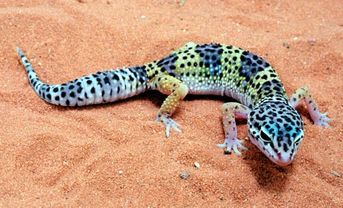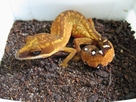Leopard Normal Babies Gecko - Eublepharis macularius

Leopard make great pets. They are small-sized, gentle, well-dispositioned lizards. Leopard geckos rarely bite. Unlike the gecko most people think of, Leos do not have "suction cup" feet. They can't climb walls or glass like their cousins, but they do like to climb and explore things like rocks and logs. Leos are very easy to keep as pets and are very resilient. A healthy Leopard requires little more than heat, a house, food, water and a clean tank. Remember when choosing a Leopard gecko as a pet that it could live 10 to 20 years. This animal will be with you for a long time and you are responsible for its care.
Leopard geckos are found in Iran, Iraq, Afghanistan, Pakistan, and India. They are terrestrial (live on the ground) lizards, inhabiting arid regions and preferring rocky desert areas or grasslands over areas of open sand. They get their name from the leopard-like spots that cover their bodies. Juveniles are quite different in appearance, being banded and boldly colored. The banding and color intensity gradually fades as the young gecko matures. Typically, adults are about 8 to 10 inches from tip of nose to tip of tail and weigh 45 to 65 grams. Leopard geckos are in the sub-family Eublepharinae, which means having eye-lids. Unlike many geckos, Leos can blink and sleep with their eyes closed. In the wild they will eat mostly insects such as spiders and scorpions but are opportunistic and will eat most anything they can crush with their powerful jaws (for their size) and swallow. Leopard geckos are nocturnal (night-time) lizards and retreat into cooler burrows or rock crevices during the day.
Housing:
Housing will be discussed first since you shouldn't bring home your new pet until you have everything to take care of the it. A single Leopard gecko can be housed in a ten gallon tank, two or more should have more room. Obviously a ten gallon tank is the minimum and your Leo won't complain about extra room. Typically, a group of three Leos will be comfortable in a 20 gallon-long tank. The tank needs a hide box for the gecko to sleep in. The black plastic hide boxes available at most pet stores work very well and are easy to clean. Place a metal-screen top on the tank (pet shops sell these), more to keep the crickets in than the gecko. Use metal screen tops as they allow lights to be placed on top of the tank without fear of burning.
Leopard geckos can go quite a while without water, getting much of their water needs from the prey they eat, but you must still provide a shallow water dish to supplement their water requirements. The molded plastic dishes commonly sold for lizards are great as they are not too deep, so neither the gecko nor crickets they eat will drown and the plastic is easy to keep clean.
You should also provide a moist hide box for your pet. Lizards periodically shed their skin. When they are shedding it is VERY important that they have a place of high humidity to go to. The high humidity keeps the shedding skin soft and pliable. This allows the skin to peel off easily. Without this the skin might become dry and stick to the gecko. If the old skin does not shed properly it cause health problems. The most common problem is the old skin on the toes "strangles' the blood flow to the toes. It is uncommon to see a Leo that had some shed problems as a juvenile and now has one or two shorten or missing toes. Improper shedding can also stick to the gecko's eyelid. This dead skin around the eyes can become infected and damage the geckos eyes. These problems are easily avoided by providing a moist box and KEEPING it moist.
A moist box is very easy to make. Take a plastic container with a sealable lid and cut a round hole in it big enough for the gecko to get in and out of. One of the best containers is a margarine "tub". They are tapered and sit well if you place them in the tank upside down. The hole you cut can be on the side or top, the gecko will find it. You can use moist paper towels on the bottom of the box (as pictured) or you can partially fill the box with moist fine-grained vermiculite. If you use moist vermiculite, I advise putting the hole at the top of the hide box (bottom of margarine tub) because the vermiculite stays in the box this way. With the hole on the side, the geckos often kick the vermiculite out. After cutting the hole you may want to take a match and flame the edge of the hole. This slightly melts the sharp edges of the opening. Two or three times a week mist the box to keep it moist, but don't make it so moist that free standing water exists. Change the paper towel when spoiled, discolored or torn up and the vermiculite monthly. Often the gecko will prefer the moist box to the hide box as a permanent house, but keep both in the tank to give the gecko a choice.
Temperature & Lighting:
The tank will also need heat and optionally a light. Light is needed only to give the gecko a normal light cycle. Since leos are nocturnal and hide in shelters during the day they do not require UV light. Use a regular incandescent aquarium light fixture for daylight for the gecko. You can use either an overhead heat lamp or an undertank heat pad. Avoid heat rocks as they provide only a small heated area. Whichever you use, place it at one end of the tank to provide the greatest temperature gradient and allow the Leo to choose its own comfort zone. There should be one spot in the tank that the surface temperature reaches 88 to 90 F. Air temperature should be 85 to 90 at the hot end of the tank. Leave the heat (either heat lamp or heat pad) on 24 hours a day. Heat lamps are advantageous in that they provide both heat and a "moonlight" effect at night. The night-time reptile bulbs give off a dim red or purple glow that won't bother you too much but lets you see and enjoy your gecko when it is out and active at night. You may also want to put the daylight fixture on a timer and give the gecko 10 to 14 hours of light depending on the season (10 hrs. winter 12hrs. fall/spring and 14hrs. summer). At night the temperature may drop (because the daylight bulb is off) and can go as low as the lower 70's. One final note on temperature, don't place the tank in an area of extreme temperature fluctuation. This includes in windows with direct sunlight that might overheat the tank and drafty areas that could chill the geckos.
Substrate:
The final piece of the tank is the substrate you put on the bottom for the gecko to walk on. This can be orchid bark, newspaper, sand or carpet (astroturf type sold for reptiles). I don't recommend anything other than newspaper for baby geckos. They eat things they shouldn't and may ingest sand. This can cause them to become impacted and possibly die. Newspaper is very easy to clean, just change it and throw the old away. Newspaper however, isn't very attractive and doesn't seem to be the preferred substrate by Leos. For adult Leopard geckos, you can use fine play sand, purchased at the toy store or lumber yard. Once the Leo is six months old it can be moved to sand or other substrate. If you see the Leo eating sand (they lick it up) increase the calcium supplementation and place a small dish of calcium powder (e.g., Rep-Cal phosphorus-free with vitamin D-3, ultra fine blend) in the tank.

Fish Scale Gecko - Geckolepsis maculata - Golden Fish Scaled Gecko
Freshmarine: $44.50
You Save 21.92%
Before Placing Your Order
Store InformationShipping Info
Payment Info
Return Policy
Arrive Alive Guarantee
Adoptation Policy
After Placing Your Order
Track Your OrderSecurity Safe Shopping
Compatibility Chart
Shoppers Review










